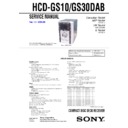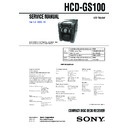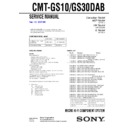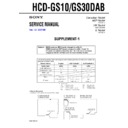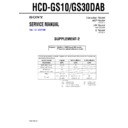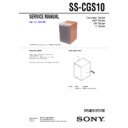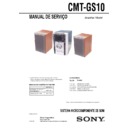Read Sony CMT-GS10 / CMT-GS30DAB / HCD-GS10 / HCD-GS30DAB Service Manual online
SERVICE MANUAL
Sony Corporation
Audio&Video Business Group
Published by Sony Techno Create Corporation
Published by Sony Techno Create Corporation
Canadian Model
AEP Model
HCD-GS10
UK Model
HCD-GS30DAB
E Model
HCD-GS10
COMPACT DISC DECK RECEIVER
9-887-580-05
2009B00-1
© 2009.02
© 2009.02
Ver. 1.4 2009.02
SPECIFICATIONS
HCD-GS10/GS30DAB
HCD-GS10/GS30DAB are the Amplifier, CD player
and Tuner section in CMT-GS10/GS30DAB.
and Tuner section in CMT-GS10/GS30DAB.
Model Name Using Similar Mechanism
HCD-EC55
Base Unit Name
BU-K6BD90-WOD
Optical Pick-up Name
KSM-213DCP
Amplifier section
Canadian model:
Continuous RMS power output (reference): 50 + 50 W (6 ohms at
1 kHz, 10% THD)
1 kHz, 10% THD)
European and Russian models:
DIN power output (rated): 45 + 45 W (6 ohms at 1 kHz, DIN)
Continuous RMS power output (reference): 50 + 50 W (6 ohms at
1 kHz, 10% THD)
Music power output (reference): 75 + 75 W
Continuous RMS power output (reference): 50 + 50 W (6 ohms at
1 kHz, 10% THD)
Music power output (reference): 75 + 75 W
Other models:
220 V AC, 50/60 Hz (Argentine model),
127 V AC, 60 Hz (Mexican model)
120 V or 240 V AC, 50/60 Hz (other models)
127 V AC, 60 Hz (Mexican model)
120 V or 240 V AC, 50/60 Hz (other models)
DIN power output (rated): 45 + 45 W (6 ohms at 1 kHz, DIN)
Continuous RMS power output (reference): 50 + 50 W (6 ohms at
1 kHz, 10% THD)
Continuous RMS power output (reference): 50 + 50 W (6 ohms at
1 kHz, 10% THD)
Inputs
AUDIO IN (stereo mini jack): Sensitivity 775 mV, impedance 22 kilohms
Outputs
PHONES (stereo mini jack): Accepts headphones with an impedance of
8 ohms or more
SPEAKER: Accepts impedance of 6 ohms
8 ohms or more
SPEAKER: Accepts impedance of 6 ohms
CD player section
System: Compact disc and digital audio system
Laser Diode Properties
Laser Diode Properties
Emission duration: continuous
Laser Output*: Less than 44.6
Laser Output*: Less than 44.6
µ
W
* This output is the value measurement at a distance of 200mm from the
objective lens surface on the Optical Pick-up Block with 7mm aperture.
Frequency response: 20 Hz – 20 kHz
Signal-to-noise ratio: More than 90 dB
Dynamic range: More than 90 dB
Signal-to-noise ratio: More than 90 dB
Dynamic range: More than 90 dB
Tuner section
DAB tuner section (UK model):
Frequency range
Band-III: 174.928 (5A) – 239.200 (13F) MHz
* For details, see “DAB frequency table”.
Antenna: FM/DAB lead antenna
Antenna terminal: 75 ohms, F female
Band-III: 174.928 (5A) – 239.200 (13F) MHz
* For details, see “DAB frequency table”.
Antenna: FM/DAB lead antenna
Antenna terminal: 75 ohms, F female
FM stereo, FM/AM superheterodyne tuner
Antenna:
Antenna:
FM/DAB lead antenna (UK)
FM lead antenna (Except UK)
AM loop antenna
FM lead antenna (Except UK)
AM loop antenna
FM tuner section:
Tuning range
Canadian model: 87.5 – 108.0 MHz (100 kHz step)
Other models: 87.5 – 108.0 MHz (50 kHz step)
Intermediate frequency: 10.7 MHz
Canadian model: 87.5 – 108.0 MHz (100 kHz step)
Other models: 87.5 – 108.0 MHz (50 kHz step)
Intermediate frequency: 10.7 MHz
AM tuner section:
Tuning range
Canadian model: 530 – 1,710 kHz (with 10 kHz tuning interval)
Canadian model: 530 – 1,710 kHz (with 10 kHz tuning interval)
531 – 1,710 kHz (with 9 kHz tuning interval)
European and Russian models: 531 – 1,602 kHz
(with 9 kHz tuning interval)
Other models:
530 – 1,710 kHz (with 10 kHz tuning interval)
531 – 1,602 kHz (with 9 kHz tuning interval)
531 – 1,602 kHz (with 9 kHz tuning interval)
Intermediate frequency: 450 kHz
Photo : HCD-GS10
DAB frequency table (Band-III)
Frequency
Label
Frequency
Label
174.928 MHz
5A
197.648 MHz
8B
176.640 MHz
5B
199.360 MHz
8C
178.352 MHz
5C
201.072 MHz
8D
180.064 MHz
5D
202.928 MHz
9A
181.936 MHz
6A
204.640 MHz
9B
183.648 MHz
6B
206.352 MHz
9C
185.360 MHz
6C
208.064 MHz
9D
187.072 MHz
6D
209.936 MHz
10A
188.928 MHz
7A
211.648 MHz
10B
190.640 MHz
7B
213.360 MHz
10C
192.352 MHz
7C
215.072 MHz
10D
194.064 MHz
7D
216.928 MHz
11A
195.936 MHz
8A
218.640 MHz
11B
Frequency
Label
220.352 MHz
11C
222.064 MHz
11D
223.936 MHz
12A
225.648 MHz
12B
227.360 MHz
12C
229.072 MHz
12D
230.784 MHz
13A
232.496 MHz
13B
234.208 MHz
13C
235.776 MHz
13D
237.488 MHz
13E
239.200 MHz
13F
(UK model)
— Continued on next page —
2
HCD-GS10/GS30DAB
TABLE OF CONTENTS
1.
SERVICING NOTES
................................................
3
2.
GENERAL
...................................................................
4
3.
DISASSEMBLY
3-1.
Disassembly Flow ...........................................................
6
3-2.
Side Panel (R) and Side Panel (L) ...................................
7
3-3.
Top Panel, DAB Board (UK) ...........................................
7
3-4.
Front Panel Assy ..............................................................
8
3-5.
PANEL Board ..................................................................
8
3-6.
HP Board, AUX Board ....................................................
9
3-7.
DC Fan ............................................................................
9
3-8.
MAIN Board .................................................................... 10
3-9.
REG Board, WIRE HOLD Board ................................... 10
3-10. AC Cord, Tuner (UK) ...................................................... 11
3-11. CD Mechanism ................................................................ 11
3-12. AMP Board ...................................................................... 12
3-13. PT Board, Power Transformer ......................................... 12
3-14. Belt .................................................................................. 13
3-15. Optical Pick-up (KSM-213DCP), BD90 Board .............. 14
3-11. CD Mechanism ................................................................ 11
3-12. AMP Board ...................................................................... 12
3-13. PT Board, Power Transformer ......................................... 12
3-14. Belt .................................................................................. 13
3-15. Optical Pick-up (KSM-213DCP), BD90 Board .............. 14
4.
TEST MODE
............................................................... 15
5.
ELECTRICAL ADJUSTMENTS
.......................... 17
6.
DIAGRAMS
6-1.
Block Diagram — BD/DRIVER Section — .................. 20
6-2.
Block Diagram — TUNER Section — .......................... 21
6-3.
Block Diagram — MAIN Section — ............................. 22
6-4.
Printed Wiring Board — BD90 Board — ...................... 23
6-5.
Schematic Diagram — BD90 Board — ......................... 24
6-6.
Printed Wiring Boards
— MAIN Board , REG Board — .................................... 25
— MAIN Board , REG Board — .................................... 25
6-7.
Schematic Diagram
— MAIN Board (1/2), REG Board — ............................ 26
— MAIN Board (1/2), REG Board — ............................ 26
6-8.
Schematic Diagram — MAIN Board (2/2) — ............... 27
6-9.
Printed Wiring Board — AMP Board — ....................... 28
6-10. Schematic Diagram — AMP Board — .......................... 29
6-11. Printed Wiring Boards
6-11. Printed Wiring Boards
— PANEL Board , KEY Board (AEP) — ...................... 30
6-12. Schematic Diagram
— PANEL Board , KEY Board (AEP) — ...................... 31
6-13. Printed Wiring Boards
— AUX Board , HP Board — ......................................... 32
6-14. Schematic Diagram
— AUX Board , HP Board — ......................................... 32
6-15. Printed Wiring Board
— PT Board (CND, AEP, UK, RU) — ........................... 33
6-16. Schematic Diagram
— PT Board (CND, AEP, UK, RU) — ........................... 33
7.
EXPLODED VIEWS
7-1.
Overall Section ................................................................ 40
7-2.
Front Panel Section ......................................................... 41
7-3.
Chassis Section ................................................................ 42
7-4.
CD Mechanism Section ................................................... 43
8.
ELECTRICAL PARTS LIST
.................................. 44
Ver. 1.3
Printed wiring boards, schematic diagrams and electrical parts lists are changed.
See REVISION HISTORY for details of changes on the last page.
See REVISION HISTORY for details of changes on the last page.
•
Abbreviation
AR
AR
: Argentine model
CND : Canadian model
E2
E2
: 120 V AC area in E model
E51
: Chilean and Peruvian models
MX
: Mexican model
RU
: Russian model
SP
: Singapore model
General
Power requirements:
Canadian model: 120 V AC, 60 Hz
European and Russian models: 230 V AC, 50/60 Hz
Argentine model: 220 V AC, 50/60 Hz
Mexican model: 127 V AC, 60 Hz
Other models: 120 V, 220 V or 230 – 240 V AC, 50/60 Hz,
European and Russian models: 230 V AC, 50/60 Hz
Argentine model: 220 V AC, 50/60 Hz
Mexican model: 127 V AC, 60 Hz
Other models: 120 V, 220 V or 230 – 240 V AC, 50/60 Hz,
adjustable with voltage selector
Power consumption:
Canadian model: 100 W
European model: 110 W
Other models: 110 W
European model: 110 W
Other models: 110 W
Dimensions (w/h/d) (excl. speakers): Approx. 170
×
246
×
307.5 mm
Mass (excl. speakers): Approx. 4.0 kg
Design and specifications are subject to change without notice.
Service manual
Original
SUPPLEMENT-1
SUPPLEMENT-2
Board name
suffix
suffix
suffix
MAIN (REG) board
-11, -12
-13
PANEL (KEY) board
-11
-12, -13
BD90 board
All
DAB board (UK model)
-13
Others
-11 to -13
PT board
CND, AEP, UK, RU
AR, E2, E51, SP
MX
All suffix
Suffix-12, -13
Suffix-13
SAFETY-RELATED COMPONENT WARNING!!
COMPONENTS IDENTIFIED BY MARK
0
OR DOTTED LINE
WITH MARK
0
ON THE SCHEMATIC DIAGRAMS AND IN
THE PARTS LIST ARE CRITICAL TO SAFE OPERATION.
REPLACE THESE COMPONENTS WITH SONY PARTS WHOSE
PART NUMBERS APPEAR AS SHOWN IN THIS MANUAL OR
IN SUPPLEMENTS PUBLISHED BY SONY.
REPLACE THESE COMPONENTS WITH SONY PARTS WHOSE
PART NUMBERS APPEAR AS SHOWN IN THIS MANUAL OR
IN SUPPLEMENTS PUBLISHED BY SONY.
ATTENTION AU COMPOSANT AYANT RAPPORT
À LA SÉCURITÉ!
LES COMPOSANTS IDENTIFIÉS PAR UNE MARQUE
0
SUR
LES DIAGRAMMES SCHÉMATIQUES ET LA LISTE DES
PIÈCES SONT CRITIQUES POUR LA SÉCURITÉ DE
FONCTIONNEMENT. NE REMPLACER CES COM- POSANTS
QUE PAR DES PIÈCES SONY DONT LES NUMÉROS SONT
DONNÉS DANS CE MANUEL OU DANS LES SUPPLÉMENTS
PUBLIÉS PAR SONY.
PIÈCES SONT CRITIQUES POUR LA SÉCURITÉ DE
FONCTIONNEMENT. NE REMPLACER CES COM- POSANTS
QUE PAR DES PIÈCES SONY DONT LES NUMÉROS SONT
DONNÉS DANS CE MANUEL OU DANS LES SUPPLÉMENTS
PUBLIÉS PAR SONY.
3
HCD-GS10/GS30DAB
Notes on chip component replacement
•
Never reuse a disconnected chip component.
•
Notice that the minus side of a tantalum capacitor may be
damaged by heat.
damaged by heat.
Flexible Circuit Board Repairing
•
Keep the temperature of the soldering iron around 270
°
C
during repairing.
•
Do not touch the soldering iron on the same conductor of the
circuit board (within 3 times).
circuit board (within 3 times).
•
Be careful not to apply force on the conductor when soldering
or unsoldering.
or unsoldering.
CAUTION
Use of controls or adjustments or performance of procedures
other than those specified herein may result in hazardous radiation
exposure.
other than those specified herein may result in hazardous radiation
exposure.
UNLEADED SOLDER
Boards requiring use of unleaded solder are printed with the lead-
free mark (LF) indicating the solder contains no lead.
(Caution: Some printed circuit boards may not come printed with
free mark (LF) indicating the solder contains no lead.
(Caution: Some printed circuit boards may not come printed with
the lead free mark due to their particular size)
: LEAD FREE MARK
Unleaded solder has the following characteristics.
•
Unleaded solder melts at a temperature about 40
°
C higher
than ordinary solder.
Ordinary soldering irons can be used but the iron tip has to be
applied to the solder joint for a slightly longer time.
Soldering irons using a temperature regulator should be set to
about 350
Ordinary soldering irons can be used but the iron tip has to be
applied to the solder joint for a slightly longer time.
Soldering irons using a temperature regulator should be set to
about 350
°
C.
Caution: The printed pattern (copper foil) may peel away if
the heated tip is applied for too long, so be careful!
•
Strong viscosity
Unleaded solder is more viscou-s (sticky, less prone to flow)
than ordinary solder so use caution not to let solder bridges
occur such as on IC pins, etc.
Unleaded solder is more viscou-s (sticky, less prone to flow)
than ordinary solder so use caution not to let solder bridges
occur such as on IC pins, etc.
•
Usable with ordinary solder
It is best to use only unleaded solder but unleaded solder may
also be added to ordinary solder.
It is best to use only unleaded solder but unleaded solder may
also be added to ordinary solder.
The laser diode in the optical pick-up block may suffer electrostatic
break-down because of the potential difference generated by the
charged electrostatic load, etc. on clothing and the human body.
During repair, pay attention to electrostatic break-down and also
use the procedure in the printed matter which is included in the
repair parts.
The flexible board is easily damaged and should be handled with
care.
break-down because of the potential difference generated by the
charged electrostatic load, etc. on clothing and the human body.
During repair, pay attention to electrostatic break-down and also
use the procedure in the printed matter which is included in the
repair parts.
The flexible board is easily damaged and should be handled with
care.
NOTES ON LASER DIODE EMISSION CHECK
The laser beam on this model is concentrated so as to be focused on
the disc reflective surface by the objective lens in the optical pick-
up block. Therefore, when checking the laser diode emission,
observe from more than 30 cm away from the objective lens.
the disc reflective surface by the objective lens in the optical pick-
up block. Therefore, when checking the laser diode emission,
observe from more than 30 cm away from the objective lens.
SECTION 1
SERVICING NOTES
This appliance is classified as a CLASS 1 LASER product.
The CLASS 1 LASER PRODUCT MARKING is located on
the rear exterior.
The CLASS 1 LASER PRODUCT MARKING is located on
the rear exterior.
Laser component in this product is capable of emitting radiation
exceeding the limit for Class 1.
exceeding the limit for Class 1.
When carrying this system
1
Press the
?/1
button to turn the power on.
Insert a disc.
2
Press the CD
u
button to select CD function.
While pressing the
x
button, press the
Z
button for
more 5 seconds.
3
The message “LOCKED” is displayed and the disc slot
is locked. (Even if exiting from this mode, the disc slot
is still locked)
is locked. (Even if exiting from this mode, the disc slot
is still locked)
NOTES ON HANDLING THE OPTICAL PICK-UP
BLOCK OR BASE UNIT
BLOCK OR BASE UNIT
CAUTION
Ver. 1.3
MODEL IDENTIFICATION
– Rear Panel –
– Rear Panel –
•
Abbreviation
AR
AR
: Argentine model
CND : Canadian model
E2
E2
: 120 V AC area in E model
E51 : Chilean and Peruvian models
MX : Mexican model
RU
MX : Mexican model
RU
: Russian model
SP
: Singapore model
Model
Part No.
GS10 : E2, E51 models
2-319-562-0
[]
GS10 : MX model
2-319-563-0
[]
GS10 : AR model
2-319-756-0
[]
GS10 : SP model
2-319-760-0
[]
GS10 : AEP model
2-899-469-0
[]
GS10 : RU model
2-899-470-0
[]
GS10 : CND model
2-899-471-0
[]
GS30DAB : UK model
3-099-988-0
[]
Parts No.
4
HCD-GS10/GS30DAB
SECTION 2
GENERAL
This section is extracted
from instruction manual.
from instruction manual.
Basic Operations
Before using the system
To use the remote
Slide and remove the battery compartment lid ȹ, and
insert the two R6 (size AA) batteries (supplied), × side
first, matching the polarities shown below.
insert the two R6 (size AA) batteries (supplied), × side
first, matching the polarities shown below.
Notes on using the remote
ˎWith normal use, the batteries should last for about six months.
ˎDo not mix an old battery with a new one or mix different types of
ˎWith normal use, the batteries should last for about six months.
ˎDo not mix an old battery with a new one or mix different types of
batteries.
ˎIf you do not use the remote for a long period of time, remove the
batteries to avoid damage from battery leakage and corrosion.
To set the clock
1
Turn on the system.
Press ÒÄÆ (on/standby) ȩ.
Press ÒÄÆ (on/standby) ȩ.
2
Select the clock set mode.
Press CLOCK/TIMER SET ȷ on the remote. If the
current mode appears on the display, press Ã/Ñ
ȵ on the remote repeatedly to select “CLOCK,” and
then press ENTER ȸ on the remote.
Press CLOCK/TIMER SET ȷ on the remote. If the
current mode appears on the display, press Ã/Ñ
ȵ on the remote repeatedly to select “CLOCK,” and
then press ENTER ȸ on the remote.
3
Set the time.
Press Ã/Ñ ȵ on the remote repeatedly to set
the hour, and then press ENTER ȸ on the remote.
Use the same procedure to set the minutes.
The clock settings are lost when you disconnect the
power cord or if a power failure occurs.
To display the clock when the system is off, press
DISPLAY Ȭ. The clock is displayed for about 8
seconds.
Press Ã/Ñ ȵ on the remote repeatedly to set
the hour, and then press ENTER ȸ on the remote.
Use the same procedure to set the minutes.
The clock settings are lost when you disconnect the
power cord or if a power failure occurs.
To display the clock when the system is off, press
DISPLAY Ȭ. The clock is displayed for about 8
seconds.
Selecting a music source
Press the following buttons (or press FUNCTION Ȯ on
the remote repeatedly).
the remote repeatedly).
To select
Press
CD
CD Ȯ on the remote.
Tuner
TUNER/BAND Ȯ.
Component (connected using
an audio cord)
an audio cord)
AUDIO IN Ȯ.
Adjusting the sound
To adjust the volume
Press VOLUME +/ˋ on the remote (or turn the
VOLUME control on the unit) ȱ.
VOLUME control on the unit) ȱ.
To add a sound effect
To
Press
Generate a more dynamic
sound (Dynamic Sound
Generator X-tra)
sound (Dynamic Sound
Generator X-tra)
DSGX ȴ on the unit.
Set the sound effect
EQ ȴ.
Playing a CD/MP3 disc
1
Select the CD function.
Press CD on the remote (or FUNCTION on the
remote repeatedly) Ȯ.
Press CD on the remote (or FUNCTION on the
remote repeatedly) Ȯ.
2
Place a disc.
Press ì (open/close) Ȱ on the unit, and place a disc
with the label side up on the disc tray.
Press ì (open/close) Ȱ on the unit, and place a disc
with the label side up on the disc tray.
To close the disc tray, press ì (open/close) Ȱ on the
unit.
Do not force the disc tray closed with your finger, as
this may damage the unit.
unit.
Do not force the disc tray closed with your finger, as
this may damage the unit.
3
Start playback.
Press à (play) (or CD ā (play/pause) on the unit)
Ȯ.
Press à (play) (or CD ā (play/pause) on the unit)
Ȯ.
To
Press
Pause playback
ê (pause) on the remote (or CD
ā on the unit) Ȯ. To resume
play, press the button again.
ā on the unit) Ȯ. To resume
play, press the button again.
Stop playback
Ą (stop) ȶ.
Select a folder on an
MP3 disc
MP3 disc
+/ˋ ȯ.
Select a track or file
Ã/Ñ (go back/go forward)
on the remote (ø/Þ on the
unit) ȵ.
on the remote (ø/Þ on the
unit) ȵ.
Find a point in a
track or file
track or file
Hold down ù/ß (rewind/
fast forward) ȵ during playback,
and release the button at the
desired point.
fast forward) ȵ during playback,
and release the button at the
desired point.
Select Repeat Play
REPEAT ȭ on the remote
repeatedly until “REP” or “REP1”
appears.
repeatedly until “REP” or “REP1”
appears.
To change the play mode
Press PLAY MODE ȭ repeatedly while the player is
stopped. You can select normal play (“
stopped. You can select normal play (“
” for all MP3
files in the folder on the disc), shuffle play (“SHUF” or
“
“
SHUF*”), or program play (“PGM”).
* When playing a CD-DA disc,
(SHUF) Play performs the same
operation as normal (shuffle) play.
Notes on Repeat Play
ˎAll tracks or files on a disc are played repeatedly up to five times.
ˎ“REP1” indicates that a single track or file is repeated until you stop
ˎAll tracks or files on a disc are played repeatedly up to five times.
ˎ“REP1” indicates that a single track or file is repeated until you stop
it.
Notes on playing MP3 discs
ˎDo not save other types of tracks or files or unnecessary folders on a
ˎDo not save other types of tracks or files or unnecessary folders on a
disc that has MP3 files.
ˎFolders that have no MP3 files are skipped.
ˎMP3 files are played back in the order that they are recorded onto
ˎMP3 files are played back in the order that they are recorded onto
the disc.
ˎThe system can only play MP3 files that have a file extension of
“.MP3”.
ˎIf there are files on the disc that have the “.MP3” file extension,
but that are not MP3 files, the unit may produce noise or may
malfunction.
malfunction.
ˎThe maximum number of:
ˋfolders is 150 (including the root folder).
ˋMP3 files is 255.
ˋMP3 files and folders that can be contained on a single disc is 256.
ˋfolder levels (the tree structure of files) is eight.
ˋMP3 files is 255.
ˋMP3 files and folders that can be contained on a single disc is 256.
ˋfolder levels (the tree structure of files) is eight.
ˎCompatibility with all MP3 encoding/writing software, recording
device, and recording media cannot be guaranteed. Incompatible
MP3 discs may produce noise or interrupted audio or may not play
at all.
MP3 discs may produce noise or interrupted audio or may not play
at all.
Notes on playing multisession discs
ˎIf the disc begins with a CD-DA (or MP3) session, it is recognized as
ˎIf the disc begins with a CD-DA (or MP3) session, it is recognized as
a CD-DA (or MP3) disc, and other sessions are not played back.
ˎA disc with a mixed CD format is recognized as a CD-DA (audio)
disc.
Listening to the radio
1
Select “FM” or “AM.”
Press TUNER/BAND Ȯ repeatedly.
Press TUNER/BAND Ȯ repeatedly.
2
Select the tuning mode.
Press TUNING MODE ȭ repeatedly until “AUTO”
appears.
Press TUNING MODE ȭ repeatedly until “AUTO”
appears.
3
Tune in the desired station.
Press +/ˋ on the remote (or TUNING + or ˋ on the
unit) ȵ. Scanning stops automatically when a station
is tuned in, and then “TUNED” and “STEREO” (for
stereo programs only) appear.
Press +/ˋ on the remote (or TUNING + or ˋ on the
unit) ȵ. Scanning stops automatically when a station
is tuned in, and then “TUNED” and “STEREO” (for
stereo programs only) appear.
To stop automatic scanning
Press Ą (stop) ȶ.
To tune in a station with a weak signal
If “TUNED” does not appear and the scanning does
not stop, press TUNING MODE ȭ repeatedly until
“MANUAL” appears and press +/ˋ on the remote (or
TUNING + or ˋ on the unit) ȵ repeatedly to tune in
the desired station.
not stop, press TUNING MODE ȭ repeatedly until
“MANUAL” appears and press +/ˋ on the remote (or
TUNING + or ˋ on the unit) ȵ repeatedly to tune in
the desired station.
To reduce static noise on a weak FM stereo
station
station
Press FM MODE ȭ on the remote repeatedly until
“MONO” appears to turn off stereo reception.
“MONO” appears to turn off stereo reception.
Changing the display
To
Press
Change
information on the
display
information on the
display
1)
DISPLAY ̗ repeatedly when the
system is on.
system is on.
Check the clock
when the system
is off
when the system
is off
DISPLAY ̗ when the system is
off
off
2)
. The clock is displayed for 8
seconds.
1)
For example, you can view CD/MP3 disc information, such as the
track or file number or folder name during normal play, or the total
playing time while the player is stopped.
track or file number or folder name during normal play, or the total
playing time while the player is stopped.
2)
The STANDBY indicator
Ȫ
on the unit lights up when the system is
turned off.
Notes on the display information
ˎThe following are not displayed:
ˎThe following are not displayed:
ˋtotal playing time for a CD-DA disc depending on the play mode.
ˋtotal playing time for an MP3 disc.
ˋremaining playing time for a track and an MP3 file.
ˋtotal playing time for an MP3 disc.
ˋremaining playing time for a track and an MP3 file.
ˎThe following are not displayed correctly:
ˋelapsed playing time of an MP3 file encoded using a VBR (variable
bit rate).
ˋfolder and file names that do not follow either the ISO9660
Level 1, Level 2 or Joliet in the expansion format.
ˎThe following are displayed:
ˋID3 tag information for MP3 files when ID3 version 1 and version
2 tags are used.
ˋup to 15 characters of ID3 tag information using uppercase letters
(A to Z), numbers (0 to 9), and symbols (‘< > * + , ˋ / @ [ \ ] _).
Using optional audio components
To connect an optional headphones
Connect headphones to the PHONES jack ȳ on the
unit.
unit.
To connect an optional component
Connect additional audio source components to the
AUDIO IN jack Ȳ on the unit using an analog audio
cord (not supplied). Turn down the volume on the
system, and then select the AUDIO IN function.
AUDIO IN jack Ȳ on the unit using an analog audio
cord (not supplied). Turn down the volume on the
system, and then select the AUDIO IN function.

